Background
- Oregano (Origanum vulgare) leaves, stems, and flowers are used medicinally. Oregano has been recognized for its aromatic properties since ancient times. Today, oregano is commonly used as a food flavoring and preservative.
- Traditionally, oregano has been used to treat respiratory, gastrointestinal, and menstrual problems. Modern herbalists recommend application of oregano oil on the skin for the treatment of infection.
- According to early research, oregano may have antiparasitic, antifungal, antioxidant, antibacterial, and insect repellent properties. Oregano may also reduce the risk of heart disease and is occasionally used in dentistry. There is limited scientific evidence to support any of these suggested uses for oregano.
References
- Bagamboula CF, Uyttendaele M, Debevere J. Antimicrobial effect of spices and herbs on Shigella sonnei and Shigella flexneri. J Food Prot 2003;66(4):668-673.
View Abstract - Burt SA, Reinders RD. Antibacterial activity of selected plant essential oils against Escherichia coli O157:H7. Lett Appl Microbiol 2003;36(3):162-167.
View Abstract - Chami F, Chami N, Bennis S, et al. Oregano and clove essential oils induce surface alteration of Saccharomyces cerevisiae. Phytother Res 2005;19(5):405-408.
View Abstract - Chorianopoulos N, Kalpoutzakis E, Aligiannis N, et al. Essential oils of Satureja, Origanum, and Thymus species: chemical composition and antibacterial activities against foodborne pathogens. J Agric Food Chem 2004;52(26):8261-8267.
View Abstract - Ciganda C, Laborde A. Herbal infusions used for induced abortion. J Toxicol Clin Toxicol 2003;41(3):235-239.
View Abstract - Dorman HJ, Deans SG. Antimicrobial agents from plants: antibacterial activity of plant volatile oils. J Appl Microbiol 2000;88(2):308-316.
View Abstract - Exarchou V, Nenadis N, Tsimidou M, et al. Antioxidant activities and phenolic composition of extracts from Greek oregano, Greek sage, and summer savory. J Agric Food Chem 2002;50(19):5294-5299.
View Abstract - Force M, Sparks WS, Ronzio RA. Inhibition of enteric parasites by emulsified oil of oregano in vivo. Phytother Res 2000;14(3):213-214.
View Abstract - Giordani R, Regli P, Kaloustian J, et al. Antifungal effect of various essential oils against Candida albicans. Potentiation of antifungal action of amphotericin B by essential oil from Thymus vulgaris. Phytother Res 2004;18(12):990-995.
View Abstract - Goun E, Cunningham G, Solodnikov S, et al. Antithrombin activity of some constituents from Origanum vulgare. Fitoterapia 2002;73(7-8):692-694.
View Abstract - Klement AA, Fedorova ZD, Volkova SD, et al. [Use of a herbal infusion of Origanum in hemophilia patients during tooth extraction]. Probl.Gematol.Pereliv.Krovi 1978;(7):25-28.
View Abstract - Lambert RJ, Skandamis PN, Coote PJ, et al. A study of the minimum inhibitory concentration and mode of action of oregano essential oil, thymol and carvacrol. J Appl Microbiol 2001;91(3):453-462.
View Abstract - Marino M, Bersani C, Comi G. Impedance measurements to study the antimicrobial activity of essential oils from Lamiaceae and Compositae. Int J Food Microbiol 2001;67(3):187-195.
View Abstract - Nevas M, Korhonen AR, Lindstrom M, et al. Antibacterial efficiency of Finnish spice essential oils against pathogenic and spoilage bacteria. J Food Prot 2004;67(1):199-202.
View Abstract - Ozdemir B, Ekbul A, Topal NB, et al. Effects of Origanum onites on endothelial function and serum biochemical markers in hyperlipidaemic patients. J Int Med Res 2008;36(6):1326-1334.
View Abstract







